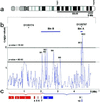Genetic and physiological data implicating the new human gene G72 and the gene for D-amino acid oxidase in schizophrenia
- PMID: 12364586
- PMCID: PMC129739
- DOI: 10.1073/pnas.182412499
Genetic and physiological data implicating the new human gene G72 and the gene for D-amino acid oxidase in schizophrenia
Erratum in
- Proc Natl Acad Sci U S A 2002 Dec 24;99(26):17221. Ouelette, G [corrected to Ouellette, G]; Realson, J [corrected to Raelson, J]
Abstract
A map of 191 single-nucleotide polymorphism (SNPs) was built across a 5-Mb segment from chromosome 13q34 that has been genetically linked to schizophrenia. DNA from 213 schizophrenic patients and 241 normal individuals from Canada were genotyped with this marker set. Two 1,400- and 65-kb regions contained markers associated with the disease. Two markers from the 65-kb region were also found to be associated to schizophrenia in a Russian sample. Two overlapping genes G72 and G30 transcribed in brain were experimentally annotated in this 65-kb region. Transfection experiments point to the existence of a 153-aa protein coded by the G72 gene. This protein is rapidly evolving in primates, is localized to endoplasmic reticulum/Golgi in transfected cells, is able to form multimers and specifically binds to carbohydrates. Yeast two-hybrid experiments with the G72 protein identified the enzyme d-amino acid oxidase (DAAO) as an interacting partner. DAAO is expressed in human brain where it oxidizes d-serine, a potent activator of N-methyl-D-aspartate type glutamate receptor. The interaction between G72 and DAAO was confirmed in vitro and resulted in activation of DAAO. Four SNP markers from DAAO were found to be associated with schizophrenia in the Canadian samples. Logistic regression revealed genetic interaction between associated SNPs in vicinity of two genes. The association of both DAAO and a new gene G72 from 13q34 with schizophrenia together with activation of DAAO activity by a G72 protein product points to the involvement of this N-methyl-d-aspartate receptor regulation pathway in schizophrenia.
Figures




Comment in
-
The discovery of susceptibility genes for mental disorders.Proc Natl Acad Sci U S A. 2002 Oct 15;99(21):13365-7. doi: 10.1073/pnas.222532599. Epub 2002 Oct 8. Proc Natl Acad Sci U S A. 2002. PMID: 12374853 Free PMC article. Review. No abstract available.
References
-
- Bromet E J, Fennig S. Biol Psychiatry. 1999;46:871–881. - PubMed
-
- Abi-Dargham A, Gil R, Krystal J, Baldwin R M, Seibyl J P, Bowers M, van Dyck C H, Charney D S, Innis R B, Laruelle M. Am J Psychiatry. 1998;155:761–767. - PubMed
-
- Olney J W, Farber N B. Arch Gen Psychiatry. 1995;52:998–1007. - PubMed
-
- Jentsch J D, Roth R H. Neuropsychopharmacology. 1999;20:201–225. - PubMed
MeSH terms
Substances
Associated data
- Actions
- Actions
- Actions
- Actions
- Actions
- Actions
LinkOut - more resources
Full Text Sources
Other Literature Sources
Medical
Molecular Biology Databases
Miscellaneous

